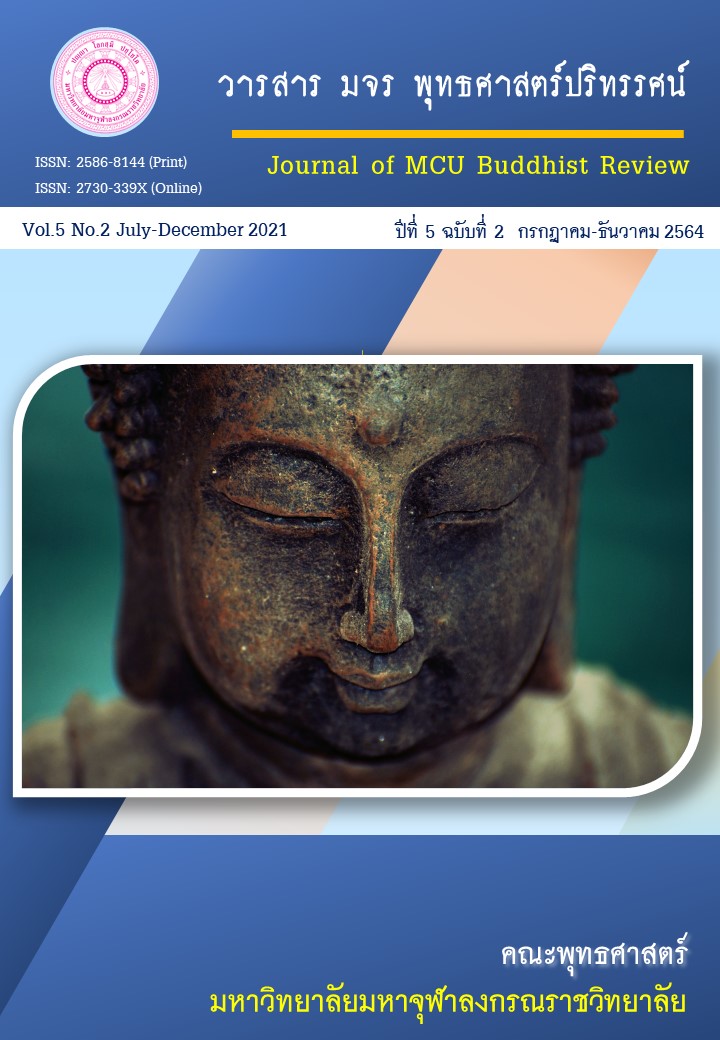พระปืด : ความศรัทธาและคุณค่าที่มีต่อวิถีชีวิตชาวพุทธในอำเภอเขวาสินรินทร์ จังหวัดสุรินทร์
Main Article Content
บทคัดย่อ
บทความนี้มีวัตถุประสงค์เพื่อ 1) ศึกษาประวัติของพระปืด 2) ศึกษาวิถีชีวิตของชาวพุทธ และ 3) วิเคราะห์ความศรัทธาและคุณค่าของพระปืดที่มีต่อวิถีชีวิตชาวพุทธในอำเภอเขวาสินรินทร์ จังหวัดสุรินทร์ การศึกษานี้เป็นการศึกษาเชิงเอกสารและลงพื้นที่สัมภาษณ์ พบว่า พระปืดเป็นพระพุทธรูปศิลปะล้านช้างแบบพื้นถิ่นอีสาน สร้างในสมัยพุทธศตวรรษที่ 23 เปรียบเสมือนสัญลักษณ์รูปแทนของพระพุทธเจ้า ที่มนุษย์สร้างขึ้นเพื่อถวายเป็นพุทธบูชาอันแฝงด้วยหลักธรรมคำสอนอยู่ด้วย เป็นการเผยแผ่พระพุทธศาสนาเชิงสัญลักษณ์ และเป็นที่ยึดเหนี่ยวทางใจ วิถีชีวิตชาวอำเภอเขวาสิน รินทร์ ยึดมั่นในพระพุทธเจ้าเป็นที่พึ่งอันสูงสุด และหลักคำสอนของพระองค์ และยังคงอนุรักษ์ประเพณีวัฒนธรรมดั้งเดิมไว้ให้ชนรุ่นหลัง ความศรัทธาและคุณค่าพระปืดที่มีต่อวิถีชีวิตชาวพุทธในอำเภอเขวาสินรินทร์ มีความศรัทธาในพระพุทธศาสนา ผลของความศรัทธาเป็นพื้นฐานทำให้เกิดปัญญา เกิดคุณค่าต่อวิถีชีวิต โดยนำเสนอแบบพรรณนาวิเคราะห์ในองค์รวม 3 ด้าน คือ 1) ด้านจิตใจ มีความเชื่อในองค์พระปืดว่า เป็นสัญลักษณ์รูปแทนของพระพุทธเจ้า เป็นสัญลักษณ์ของความดีงาม เป็นที่พึ่งทางจิตใจ สร้างขวัญกำลังใจ และเป็นหนทางแห่งการทำบุญกุศลของชาวพุทธ 2) ด้านสังคม ทำให้เกิดการสร้างสรรค์ในศิลปะขนบธรรมเนียมประเพณีของชาวพุทธ และมีความสามัคคีในสังคม และ 3) ด้านปัญญา นำหลักธรรมคำสอนทางพระพุทธศาสนาไปปรับใช้ในชีวิตประจำวัน นับได้ว่า พระปืดเป็นพระศักดิ์สิทธิ์คู่บ้านคู่เมือง ที่โน้มน้าวจิตใจชาวพุทธให้ประพฤติปฏิบัติตนในวิถีชีวิตที่ดีงาม ดังพุทธพจน์ที่ว่า “ผู้ใดเห็นธรรม ผู้นั้นเห็นเรา”
Article Details
- บทความที่ได้รับการตีพิมพ์เป็นลิขสิทธิ์ของวารสาร มจร พุทธศาสตร์ปริทรรศน์
- ข้อความใดๆ ที่ปรากฎในบทความที่ได้รับการตีพิมพ์ในวารสาร ถือเป็นความรับผิดชอบของผู้เขียนบทความ และข้อคิดเห็นนั้นไม่ถือว่าเป็นทัศนะและความรับผิดชอบของกองบรรณาธิการวารสาร มจร พุทธศาสตร์ปริทรรศน์
เอกสารอ้างอิง
กรมการศาสนา. (2540). ประวัติวัดทั่วราชอาณาจักรเล่ม 6. กรุงเทพฯ: โรงพิมพ์ศาสนา.
กรมศิลปากร กระทรวงวัฒนธรรม. (2558). พระพุทธรูปปางต่าง ๆ. พิมพ์ครั้งที่ 4. นครปฐม : บริษัท รุ่งศิลป์การพิมพ์ (1977) จำกัด.
กลุ่มวิทยาลัยครูภาคใต้. (2526). สุราษฎร์ธานี. สงขลา : กลุ่มวิทยาลัยครูภาคใต้.
ข่าวเนชั่นทีวี. (2560). เที่ยวชุมชนโบราณ นมัสการยกพระเสี่ยงทายที่สุรินทร์. สืบค้นเมื่อวันที่ 29 กรกฎาคม 2564, จาก https://www.nationtv.tv/lifestyle/378592419.
ข่าวแนวหน้า. (2564). ตำนานพระปืด! เรื่องเล่าลี้ลับวัดปราสาทแก้ว ตั้งจิตขอพรยกพระเสี่ยงทาย. สืบค้นเมื่อวันที่ 29 กรกฎาคม 2564, จาก https://www. naewna.com/ likesara/ 590199.
คณะกรรมการบริหารงานอําเภอเขวาสินรินทร์. (2560). แผนยุทธศาสตร์พัฒนาอําเภอ 4 ปี อำเภอเขวาสินรินทร์. สืบค้นเมื่อวันที่ 29 กรกฎาคม 2564, จาก https:// www.google.com/ search? q=แผนยุทธศาสตร์พัฒนาอําเภอ+4+ปี+อำเภอเขวาสินรินทร์.
จำลอง จรจรัญ. (2564). ปราชญ์ชาวบ้าน. บ้านพระปืด ตำบลบ้านแร่ อำเภอเขวาสินรินทร์ จังหวัดสุรินทร์. สัมภาษณ์ 28 กรกฎาคม.
ฐานข้อมูลแหล่งโบราณคดีที่สำคัญในประเทศไทย. (2563). ปราสาทแก้ว. สืบค้นเมื่อวันที่ 29 กรกฎาคม 2564, จาก https://www.sac.or.th/databases/ archaeology/ archaeology/ปราสาทแก้ว.
พูนศักดิ์ กมล. (2562). คุณค่ามนุษย์แบบอัตวิสัยในมหาสติปัฏฐานสูตร. วารสารพุทธมัคค์, 4(2), 31-36.
พระครูสถิตวรรัตน์ ฐานวโร. (2564). เจ้าอาวาสวัดปราสาทแก้ว. บ้านพระปืด ตำบลบ้านแร่ อำเภอ เขวาสินรินทร์ จังหวัดสุรินทร์. สัมภาษณ์ 28 กรกฎาคม.
พระธรรมปิฎก (ป.อ. ปยุตโต). (2543). พจนานุกรมพุทธศาสตร์. พิมพ์ครั้งที่ 9. กรุงเทพมหานคร: โรงพิมพ์มหาจุฬาลงกรณราชวิทยาลัย.
พระมหาสมจินต์ สมฺมาปญฺโญ. ผศ.ดร. (2558). กำเนิดและพัฒนาการแห่งพระพุทธรูป. สืบค้นเมื่อวันที่ 29 กรกฎาคม 2564, จาก https://www.mcu.ac.th/article/detail/502.
พระครูโกวิทสุตาภรณ์. (2563). บุญข้าวสาก: มิติความเชื่อและพิธีกรรมทางศาสนากับคุณค่าเชิงจริยะในสังคมไทย. วารสาร มจร ปรัชญาปริทรรศน์, 3(2), 42-54.
ภานุวัฒน์ เอื้อสามาลย์. (2545). การศึกษาพัฒนาการชุมชนโบราณบ้านพระปืด ตำบลบ้านแร่ กิ่งอำเภอเขวาสินรินทร์ จังหวัดสุรินทร์. (วิทยานิพนธ์ศิลปศาสตรบัณฑิต (โบราณคดี) ภาควิชาโบราณคดี คณะโบราณคดี). มหาวิทยาลัยศิลปากร.
มณี พะยอมยงค์. (2536). ความเชื่อของคนไทย วัฒนธรรมพื้นบ้าน: คติความเชื่อ. กรุงเทพมหานคร: โรงพิมพ์จุฬาลงกรณ์มหาวิทยาลัย.
มหาจุฬาลงกรณราชวิทยาลัย. (2539). พระไตรปิฎกภาษาไทย ฉบับมหาจุฬาลงกรณราชวิทยาลัย. กรุงเทพมหานคร: โรงพิมพ์มหาจุฬาลงกรณราชวิทยาลัย.
มานิต มานิตเจริญ. (2514). พจนานุกรมไทย. กรุงเทพมหานคร : เอกศิลป์การพิมพ์.
ราชบัณฑิตยสถาน. (2524). พจนานุกรมศัพท์สังคมวิทยาอังกฤษ ไทย. กรุงเทพมหานคร : รุ่งศิลป์การพิมพ์.
สิงหะ ซโยจ. (2534). ประวัติวัดปราสาทแก้ว และประวัติบ้านพระปืด. จัดพิมพ์เป็นที่ระลึกในงานทอดกฐิน ณ วัดปราสาทแก้ว 1 - 2 พฤศจิกายน. เอกสารอัดสำเนา.
สมเกียรติ โล่ห์เพชรัตน์. (2543). ประวัติศาสตร์การสร้างพระพุทธรูปล้านช้าง. กรุงเทพฯ : บริษัทอมรินทร์ พริ้นติ้งแอนด์พับลิชชิ่ง จำกัด.
สมเด็จพระญาณสังวร. (2530). (เจริญ สุวฑฺฒโน). ประมวลสารคดีธรรม. กรุงเทพมหานคร: คณะกรรมการอำนวยการจัดงานเฉลิมพระเกียรติ พระบาทสมเด็จพระเจ้าอยู่หัว จัดพิมพ์เนื่องในพระราชพิธีมหามงคลเฉลิมพระชนมพรรษา 5 รอบ.
อมรา พงศาพิชญ์. (2541). วัฒนธรรมศาสนาและชาติพันธ์: วิเคราะห์สังคมไทยแนวมนุษย์วิทยา. พิมพ์ครั้งที่ 5. กรุงเทพมหานคร: โรงพิมพ์แห่งมหาจุฬาลงกรณราชวิทยาลัย.
MGR Online. (2561). มรดกทางวัฒนธรรมประเพณีชุมชนอำเภอเขวาสินรินทร์. สืบค้นเมื่อวันที่ 29 กรกฎาคม 2564, จาก https://mgronline.com/local/detail/9610000016137.


